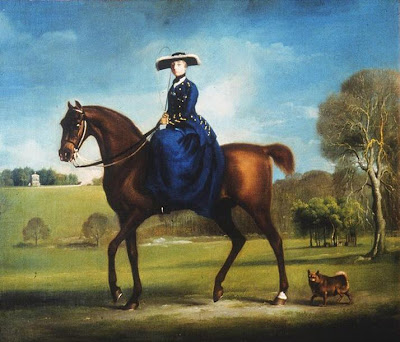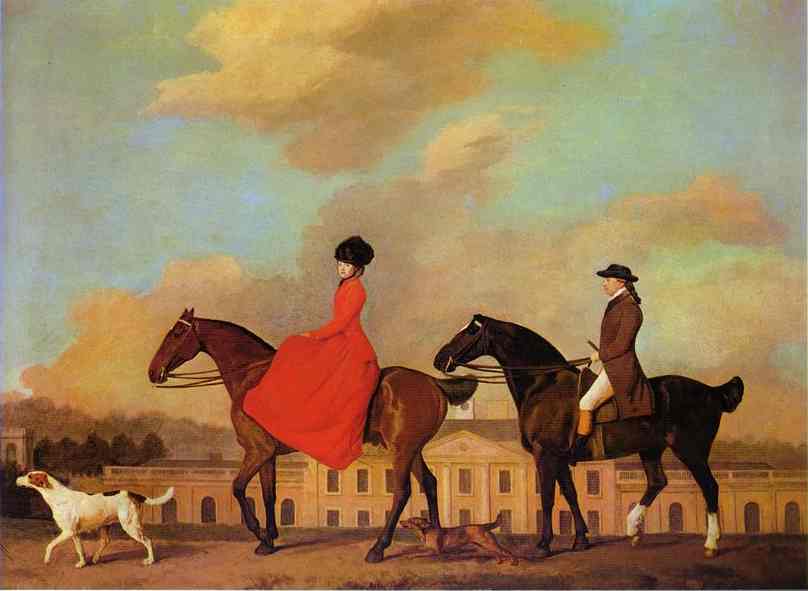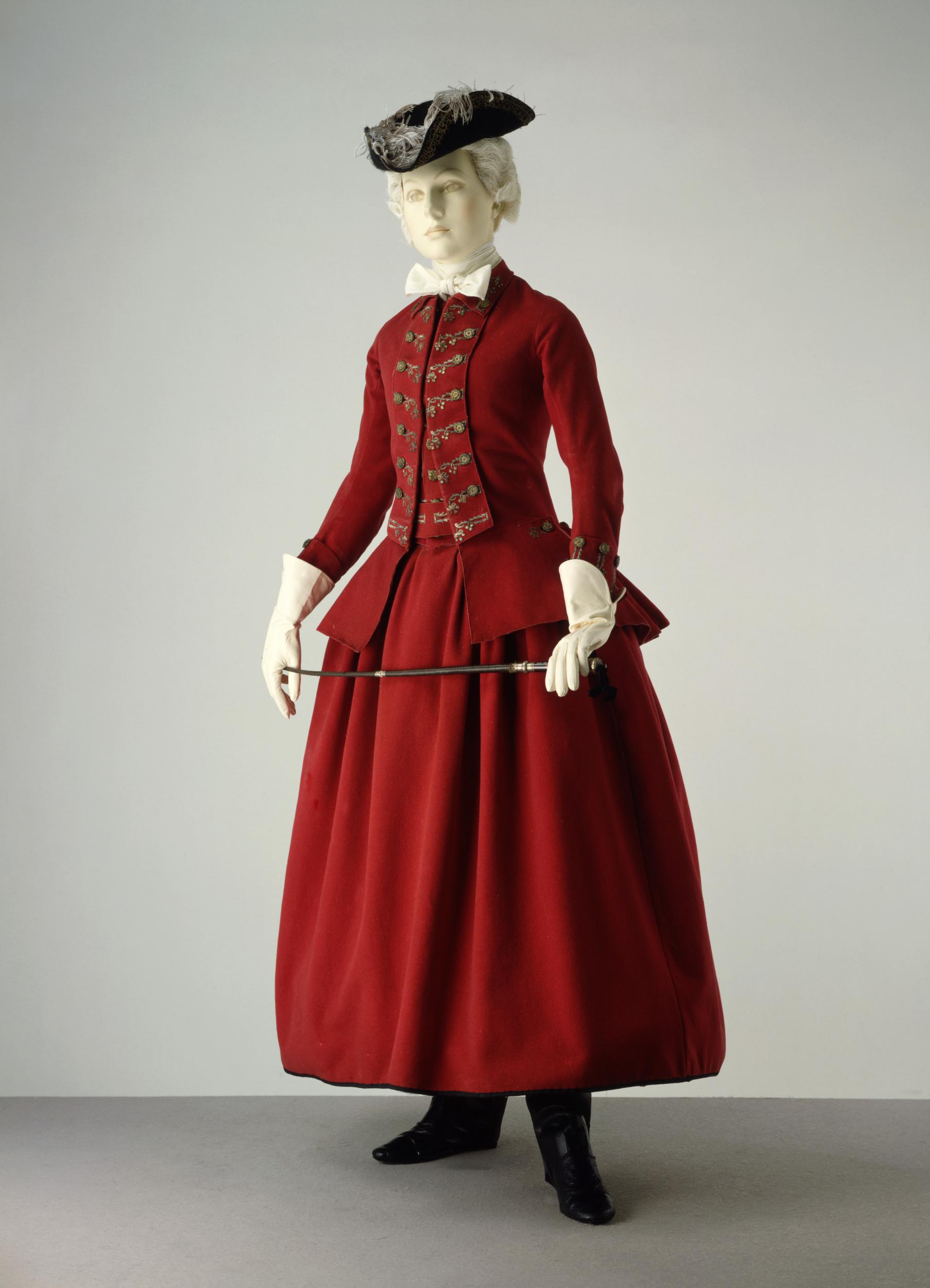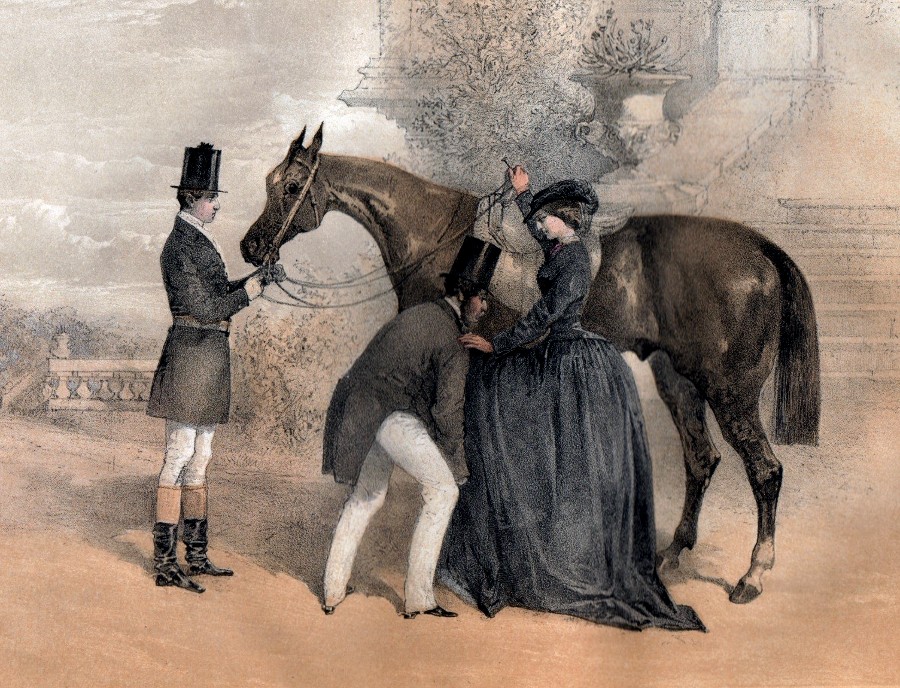Side-Saddle
The Oxford English Dictionary defines the side-saddle in the following terms:
"A saddle on which the rider sits with both legs on the same side (usually the left) of the horse, typically used by a female rider wearing a skirt. Modern side-saddles are fitted with horns or crutches to support and give a hold to the knees of the rider, who sits facing forward with one (usually the right) knee raised."
For Whom?
The very first side-saddle was designed for princess Anne of Bohemia in 1382. She rode side-saddle across Europe to marry King Richard II. It was partly intended to save her virginity. Though you could retrace numerous cases of women riding astride (cf the legend of Lady Godiva in Coventry during the middle ages for instance, Joan of Arc…), it started to be considered inappropriate and vulgar in the eighteenth century and became even more so in the nineteenth century, due to religion and morality. Consequently, the evolution of side-saddles arrived at a peak in the middle of the 19th century. Female activity began to be very popular around the world. From that time on, side-saddling became more democratic and provided most of the information about the female equestrian world. But it’s good to remember, nevertheless, that the 18th century was a forerunner and also offered a large range of elements which helped to improve the fabrication of side-saddles. Thus, in a lesser fashion, the 18th century, and mainly the 19th century, both led to the modern Victorian side-saddle that we still use today. As it was difficult to collect information about the 18th century side-saddle, some of the 19th century elements are used here to identify it more specifically.

Countess of Conings by Livery of Charlton, c1760 by George Stubbs.
George Stubbs (1724-1806) was the most famous horse painter that the 18th century ever knew. His work was remarkable in terms of realism towards English life and more specifically regarding the minute detailing of the equestrian world. In the picture, the countess of Conings is impeccably dressed by the topical "riding habits" of female riders. We cannot see details of the saddle, but the presence of the double-bridle with two pairs of reins is clearly visible. The use of this kind of bridle allows the rider to have more control over the horse thanks to the two bits in the mouth. She also has a Whipping stick used in order to replace the action of the missing leg placed on the other side of the saddle.
An Exclusive and Expensive Sport
The current side-saddle

This nowadays side-saddle might well have been manufactured by Champion & Wilson, Owen, Mayhew or even Whippy, one of the most well-known quality side saddle makers from around 1890-1940. Today it would cost more than £2000, but it was much more expensive at that time. According to Rosine Lagier, a French equestrian historian, horse riding was exclusively reserved for members of the aristocracy. Horses were extremely valuable and so was the equipment. At that time horses could not be bought for less than £60,000 (bad treatment to a horse could lead to hanging which made it even more priceworthy). Even though the price of the side saddle is not explicitly mentioned in 18th century works, one can imagine that it must have been very expensive. As equestrian sports were so exclusive, we can easily understand why there is so little information concerning the cost and the manufacture of the saddle. At that time every woman rode, but most of them did so astride. That is why there is little mentioning of this activity in the novels of the 18th century. Side saddling was very specific. One must wait for the 19th century for it to become more popular.
Description of a modern side-saddle



Origins and Evolution: From France to England
The creation of the side-saddle in England was tremendously influenced by the advance of great saddle makers in France. The pictures below show the evolution occurring in France.
Side saddle under the reign of Louis the XVth (1710-1774)

During the reign of Louis the XVth, king of France, the saddle displayed a handle on the right side. This handle was disappointing because it didn’t give balance to the rider. Moreover, as one can see, in comparison to the modern side-saddle, the fixed and leaping heads (also called pommels) were long and sharp. Thus we can presumably assume that it must have been painful for ladies’ legs to ride this way. This is why the saddle evolved under the reign of Louis the XVIth (1754-1792) but more particularly thanks to Queen Marie-Antoinette. She was well-known for her exquisite taste and her passion for horse riding. She was a source of inspiration for all the ladies of the court and consequently brought some important modifications to the side-saddle.
Side-saddle under the reign of Louis the XVIth (1754-1792) and Marie-Antoinette

Here, the saddle appears more aesthetic and much more comfortable. The seat is wider and its leather looks far suppler. The heads seems to bring more comfort and more adapted to the use of legs. This is a real progress. In his book Instruction for Ladies in Riding (1783), Captain Carter focused on how comfortable this kind of saddle must be. According to him, a strong stability would bring more safety to riders. In other words, there was less chance for ladies to fall off the horse; a incidence easily occurring at that time.
As far as Rosine Lagier is concerned, France and Britain had continuously argued about the origin of saddle making. Based on the numerous works published by great captains and riders such as La Guérinière (1687-1751), François Baucher (1796-1873) and so on and so forth, Britain was indubitably influenced by the equestrian progress in France. In his book La selle et le costume de l’amazone, étude historique et pratique de l'équitation des Dames (1897), Jules Pellier gives credit to the thesis that the English were actually inspired by French saddle makers. Indeed there was an inter-influence of both countries in the story of the evolution. In other words, it appears that France created first the basis of the saddle which were subsequently resumed by England. The French inventor of the modern side-saddle explained the possible shift from France to Britain in the following terms :

It is probable that the revolutionary period was not in favour of the progress of equestrian equipment in France for women; until the Empire there will be no sensible
improvement. In England, on the contrary, horses are greatly in honour; much care is taken of breeding and everything which has to do with its use. But Anglomania slowly steps in in France and becomes fashionable; we then get involved in the adoption of equipment that a long practice has already suggested to our neighbours.
Final Modifications Towards The Contemporary Side-Saddle
In the course of La Selle et le costume de l’amazone, Jules Pellier underlines the fact that the French saddle of the first Empire is due to English saddle making. It has become luxurious, wider and more comfortable for the rider. The pommels have become bigger which allows for a better stability for the rider.
Side-saddle of the French Revolution and the First Empire

In the image above, the improvements are quite remarkable. The two pommels are even wider than for the previous saddle. The seat appears deeper. We also notice the presence of a panel which brought more comfort for riders and horses. Shocks caused by the gaits of the trotting horse were weakened thanks to this sort of mattress. Women could subsequently trot and even canter thanks to this tremendous improvement. The manufacture of leather shows a subtle work and gives a beautiful general appearance to the saddle.
Side-saddle during the French First Empire and Restauration

This saddle is an imitation of the English side-saddle at the beginning of the 19th century. Every detail has been perfected: pommels, stirrup leathers, seat, panel. A leather crupper has been added providing less moves of the saddle on the horse’s back. Thanks to this detail, riders have a perfect seat on horses. The saddle is covered by two types of calf leather, quite refined, with stitched embroidery. The saddle has become luxurious, a great piece of work. Some saddle makers also used different sorts of material to please rich clients, like leopard’s skin for instance:

In spite of tremendous improvements, this saddle could still hurt ladies’ legs. Nevertheless the work appeared quite accomplished in comparison to the Victorian saddle of 1856.
Victorian side-saddle by Gordon & Co (1856)

All of the changes that occurred in the course of the 18th century marked a turning point in the equestrian world. Horse riding did not only serve the purpose of war and travel, but became a source of leisure and a real work of art. Ladies of the aristocracy invited guests to visit their estate on horseback. Riding side-saddle was soon associated with proper aristocratic behaviour. Horse riding was fashionable and aesthetic. The progressive improvements of the saddle brought more comfort and safer sport. It eventually led to more skilled female riders. The soft feminine outfit and more generally, the historical riding clothing came to male fashion afterwards. Side saddling became a trend and was even recommended by physicians as excellent physical activity as follows:
"Exercise in nervous disorders is superior to all medicines. Riding on horseback is generally esteemed the best, as it gives motion to the whole body, without fatiguing it. I have known some patients however, with whom walking agreed better, an others who were most benefited by riding in a carriage" (Buchan (1790))
Side Saddling, A Risky Sport?
No wonder that riding with two legs on the same side could - and still is - very unstable for the rider. In addition to this aspect, if the horse was badly broken, it could turn out to be very dangerous because the rider had no control over the animal. The picture below shows the danger of the situation. In this painting, the rider desperately lacks control over the horse which is speeding away and about to fall off the cliff. Riders and pedestrians look as though they are in complete panic at the sight of the forthcoming tragedy. It is of course a caricature, but it remains quite relevant in terms of risks due to the situation that could arise at that time.

A runaway horse approaches the edge of a cliff while the young woman rider pulls desperately on its reins. Coloured lithograph by V.J. Adam after himself, ca. 1850
This is why Carter focuses on the confection of the saddle in the excerpt below. The saddle must contribute to a certain sport aestheticism but the aspect of comfortability, stability and security must be emphasized above all.



An aesthetic sport?
As one can observe in the painting, the long skirt - though very elegant - surrounded by petticoats, was absolutely not convenient either. At the same time it was totally unsafe because women didn’t have good stability in the seat and consequently had no control over the horse. No wonder ladies could only walk their horses and were led most of the time. This process was to prevent falling. In that light, the side saddle and the riding habits of the female rider underwent many changes.

George Stubbs. John and Sophia Musters Out Riding at Colwick Hall. 1777. Oil on canvas. Private collection.
In Stubbs’s painting, Sophia Muster, a lady from the aristocracy, is elegantly depicted on her horse. She is wearing the same red costume as in the picture below. Thanks to the portrait, Stubbs highlights rich aristocrats’ will to show off their country estates, symbol of their wealth and their taste for nature and horses.

Victoria and Albert Museum, “Riding Habit”
How To Get On A Horse?

Lady in Her Riding Habit is Helped to Mount by a Gentleman While Her Groom Holds Her Horse's Head Giclee Print by Edmond Morin 19th century
Generally the lady was assisted in mounting and dismounting and was led during the ride. It was the gentleman’s job to help a lady into the saddle, check the tack and smooth her skirts. Woman needed two men to mount the horse. One held it by the bridle reins, then “the lady must lay her right hand on the top of the pommel with her whip rest on the off shoulder of the horse, and her left hand on the right shoulder of the person that is to lift her, who stooping and fixing their hands together, by intermixing their fingers, the lady will put her left foot in their hands bending her knee and raising it nearly on a line with her hip, and giving a spring she will be lift on the saddle” (Carter, 1783, 10). The lady needed help to dismount as well. Thus we can infer that side-saddling made women dependant on men. The evolution of the side-saddle and the improvement of horse breaking would progressively lead to more female independence in the upcoming 19th century.



Criticism Of Side Saddling?

The Favourite Footman, or Miss well Mounted, after John Collet, 1778, published by Sayer & Bennett, London. The British Museum.
This satire from the 18th century provides the viewer with another anecdote that emphasizes the sensual aspect of the sport and its sexual dimension. The title humorously sets the scene: a woman from British aristocracy is helped to get up on her horse thanks to a very god-looking footman. The embrace that he uses to help the lady and the position of the horse’s tail unveil a sense of promiscuity between the two protagonists. In fact during the Georgian period, it was not surprising that footmen were indeed the ladies’ favourites. This satire throws light on the paradox of this time. It was quite indecent for a lady to ride astride. Riding in this position would compromise her virtue. This is not surprising since the 18th century was known for its high level of morality. In Pamela by Richardson or in Burney’s Evelina for instance, moral conventions played a major part in high society interactions. The side-saddle appeared in those terms and social conditions. However, the satire suggests here quite a controversial attitude towards the mores. The lady rides aside, but seems to share in the same time some intimacy with the footman. This satire could be interpreted as a limit of the topical morality.

James Pollard, Coursers Taking the Field at Hatfield Park, Hertfordshire, the Seat of the Marquess of Salisbury, exhibited 1824.
In the painting, he Marquess of Salisbury appears in the middle of a hunt, side saddling with the greatest of ease. At the sight of the situation, we may wonder about the truthfulness of the scene depicted by James Pollard. Though the Marquess was allegedly known as an excellent rider - mentioned in the following terms: "the only who mounted her horse like an arrow from the land of her groom" - the viewer may remain sceptical. Considering the instability of women in side-saddles at that time, is it really possible to canter at full speed through British fields and to jump ditches and thickets?
Towards Women's Emancipation
The epitome of side saddling eventually occurred in the middle of the 19th century. From that moment on, it became more and more popular. The sport intrigued the most reckless female riders. Side saddling shows increased and the sport started to attract a huge amount of spectators.

Here, in 1866, Miss Adèle (Adèle Drouin), a very famous and international écuyère from Paris, attracted audiences from all classes, come to see her riding and breaking her
Spanish mare “blanc de lait” without any bridle… Pirouette, flying change, half pass, piaffe and passage, Spanish walk… were some of the numerous dressage movements she performed. She was regularly invited by the greatest circuses all around the world. Thanks to her performance, she gave credit to the female equestrian society. Beyond celebrity, the strong relationship that united women and horses, like Adèle and her mare Diane, raised them to the same rank as men. The fact that horses utterly obeyed them, led men to consider women as more powerful, which constituted a movement towards female emancipation.
Annotated Bibliography
Secondary Sources
Body and Gender in the Eighteenth Century, Women and Horse-Riding in the 18th Century England, https://18centurybodies.wordpress.com/2013/05/28/women-and-horse-riding-in-18th-century-england/
This website really helps me to get some directions in books. This was the most relevant website that I found concerning the 18th side-saddle considering the fact it was very difficult to find relevant information regarding my topic.
Rosine Lagier's website, http://www.rosinelagier.com/Articles/1_Articles.htm .Rosine Lagier is a female writer who is interested in female emancipation in horse-riding. Her knowledge mostly concerns the 19th century side-saddle, but as she was a acquaintance, I had the opportunity to discuss with her directly by the phone. She confirmed it was really arduous to fine relevant works in the course of the 18th century because horse-riding was exclusively a sport for members of the aristocracy. She explained me that the English side-saddle was at the origin of the modern English side-saddle. I used some of her articles to guide my research towards female emancipation.
Ladies ride aside, https://springwillowequestrian.blogspot.co.uk/p/blog-page.html . This website helped me to have a broad idea of the side-saddle timeline in England. The information are not very thorough, nevertheless it helped me to go in the right direction.
The Marchioness of Salisbury ODNB, I was curious to know more about the Marchioness of Salisbury because she was an important figure in terms of horse-riding at that time. However I was disappointed because his portrayal lacks of topical elements. She was an excellent rider, but the research did not bring as much as I was expecting. http://0-www.oxforddnb.com.pugwash.lib.warwick.ac.uk/view/article/68357?docPos=1
Primary Texts
I had difficulty finding literary sources with the possibilities that have been given to me. Nevertheless, the sources that I used brought me strong basis to show what a side-saddle in the 18th century could be.
Buchan, William. Domestic Medicine: or a Treatise on the Prevention and Cure of Diseases by Regimen and Simple Medicine,… London, 1790.
The only interesting aspect of the book lies concerning the side-saddle was the citation I wrote in my page.
Carter, Instructions for Ladies in Riding, London, 1783, Paperback - 27 May 2010. Accessed via Google books
As my work shows, I was very influenced by Carter's book. It was one of the few books that really sticks to my research. Its tone is factual, so it allowed me to add very accurate information about the subject. Carter was one of the major riders and captains in England, thus his knowledge was utterly valuable.
Pellier, J, La selle et le costume de l'Amazone (1897) Accessed via BnF (French National Library), http://gallica.bnf.fr/ark:/12148/bpt6k6578237j/f17.item.r=
I used Pellier's book as a strong basis of my work, because his description of the side-saddle was rather scientific. The different pictures and explanations of the side-saddle helped me to demonstrate the huge evolution occurred between the 18th and 19th century thanks to specific details.
Images
Images remain the strongest part of my research. All of them were quite challenging because their depiction were not always realistic. I tried to use a certain criticism to throw light on topical reality.
Figure 1: Countess of Conings by Livery of Charlton, c1760 by George Stubbs
http://georgianaduchessofdevonshire.blogspot.co.uk/2010/09/george-stubbs-equestrian-portraits.htmlSide-saddle
Figure 2: https://goo.gl/images/tpN1sZ
Figure 3,4,5: http://www.sidesaddle.com/reference/saddles.shtml
Figure 6, 7, 8, 9, 10: evolution of the side-saddle according to Jules Pellier, La selle et le costume de l'Amazone, 1897
Figure 11: article from General Advertiser (1744) (London, England), Wednesday, August 7, 1745, Issue 3347. From 17th and 18th Century Burney Collection.
Figure 12: Victorian side-saddle by Gordon & Co, https://www.museumofleathercraft.org/queen-victorias-side-saddle/
Figure 13: A runaway horse approaches the edge of a cliff while the young woman rider pulls desperately on its reins. Coloured lithograph by V.J. Adam after himself, ca. 1850, https://commons.wikimedia.org/wiki/File:A_runaway_horse_approaches_the_edge_of_a_cliff_while_the_you_Wellcome_V0023270.jpg
Figure 14: "Of the Saddle", Carter, Instructions for Ladies in Riding, London, 1783
Figure 15: George Stubbs. John and Sophia Musters Out Riding at Colwick Hall. 1777. Oil on canvas. Private collection, http://www.abcgallery.com/S/stubbs/stubbs23.html
Figure 16: Victoria and Albert Museum, “Riding Habit,” V&A Search the Collections, http://collections.vam.ac.uk/item/O74100/riding-habit-unknown/
Figure 17: Lady in Her Riding Habit is Helped to Mount by a Gentleman While Her Groom Holds Her Horse's Head Giclee Print by Edmond Morin 19th century
Figure 18, 19, 20: "Directions for Mounting" and "Directions for Dismounting", Carter, Instructions for Ladies in Riding, London, 1783.
Figure 21: The Favourite Footman, or Miss well Mounted, after John Collet, 1778, published by Sayer & Bennett, London. The British Museum.
Figure 22: James Pollard, Coursers Taking the Field at Hatfield Park, Hertfordshire, the Seat of the Marquess of Salisbury, exhibited 1824, http://www.tate.org.uk/art/artworks/pollard-coursers-taking-the-field-at-hatfield-park-hertfordshire-the-seat-of-the-marquess-t03434#3
Figure 22: Adèle Drouin, Le Nouvel Illustré, 1866
Comments (0)
You don't have permission to comment on this page.